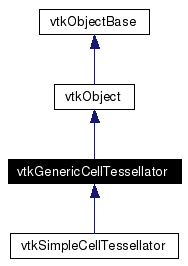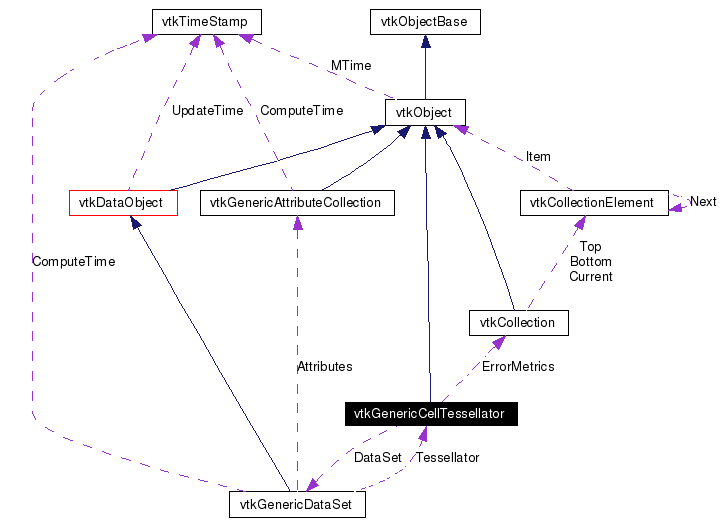
#include <vtkGenericCellTessellator.h>
Inheritance diagram for vtkGenericCellTessellator:


vtkGenericCellTessellator is a helper class to perform adaptive tessellation of particular cell topologies. The major purpose for this class is to transform higher-order cell types (e.g., higher-order finite elements) into linear cells that can then be easily visualized by VTK. This class works in conjunction with the vtkGenericDataSet and vtkGenericAdaptorCell classes.
This algorithm is based on edge subdivision. An error metric along each edge is evaluated, and if the error is greater than some tolerance, the edge is subdivided (as well as all connected 2D and 3D cells). The process repeats until the error metric is satisfied.
A significant issue addressed by this algorithm is to insure face compatibility across neigboring cells. That is, diagaonals due to face triangulation must match to insure that the mesh is compatible. The algorithm employs a precomputed table to accelerate the tessellation process. The table was generated with the help of vtkOrderedTriangulator; the basic idea is that the choice of diagonal is made by considering the relative value of the point ids.
Definition at line 59 of file vtkGenericCellTessellator.h.
Public Types | |
| typedef vtkObject | Superclass |
Public Member Functions | |
| virtual const char * | GetClassName () |
| virtual int | IsA (const char *type) |
| virtual void | Initialize (vtkGenericDataSet *ds)=0 |
| void | GetMaxErrors (double *errors) |
| void | PrintSelf (ostream &os, vtkIndent indent) |
| virtual void | TessellateFace (vtkGenericAdaptorCell *cell, vtkGenericAttributeCollection *att, vtkIdType index, vtkDoubleArray *points, vtkCellArray *cellArray, vtkPointData *internalPd)=0 |
| virtual void | Tessellate (vtkGenericAdaptorCell *cell, vtkGenericAttributeCollection *att, vtkDoubleArray *points, vtkCellArray *cellArray, vtkPointData *internalPd)=0 |
| virtual void | Triangulate (vtkGenericAdaptorCell *cell, vtkGenericAttributeCollection *att, vtkDoubleArray *points, vtkCellArray *cellArray, vtkPointData *internalPd)=0 |
| virtual void | SetErrorMetrics (vtkCollection *someErrorMetrics) |
| virtual vtkCollection * | GetErrorMetrics () |
| void | InitErrorMetrics (vtkGenericDataSet *ds) |
| int | GetMeasurement () |
| void | SetMeasurement (int flag) |
Static Public Member Functions | |
| static int | IsTypeOf (const char *type) |
| static vtkGenericCellTessellator * | SafeDownCast (vtkObject *o) |
Protected Member Functions | |
| vtkGenericCellTessellator () | |
| void | ResetMaxErrors () |
| void | SetGenericCell (vtkGenericAdaptorCell *cell) |
| ~vtkGenericCellTessellator () | |
| int | RequiresEdgeSubdivision (double *left, double *mid, double *right, double alpha) |
| virtual void | UpdateMaxError (double *leftPoint, double *midPoint, double *rightPoint, double alpha) |
Protected Attributes | |
| vtkCollection * | ErrorMetrics |
| vtkGenericDataSet * | DataSet |
| int | Measurement |
| double * | MaxErrors |
| int | MaxErrorsCapacity |
|
|
Reimplemented from vtkObject. Reimplemented in vtkSimpleCellTessellator. Definition at line 62 of file vtkGenericCellTessellator.h. |
|
|
|
|
|
|
|
|
Reimplemented from vtkObject. Reimplemented in vtkSimpleCellTessellator. |
|
|
Return 1 if this class type is the same type of (or a subclass of) the named class. Returns 0 otherwise. This method works in combination with vtkTypeRevisionMacro found in vtkSetGet.h. Reimplemented from vtkObject. Reimplemented in vtkSimpleCellTessellator. |
|
|
Return 1 if this class is the same type of (or a subclass of) the named class. Returns 0 otherwise. This method works in combination with vtkTypeRevisionMacro found in vtkSetGet.h. Reimplemented from vtkObject. Reimplemented in vtkSimpleCellTessellator. |
|
|
Reimplemented from vtkObject. Reimplemented in vtkSimpleCellTessellator. |
|
||||||||||||
|
Methods invoked by print to print information about the object including superclasses. Typically not called by the user (use Print() instead) but used in the hierarchical print process to combine the output of several classes. Reimplemented from vtkObject. Reimplemented in vtkSimpleCellTessellator. |
|
||||||||||||||||||||||||||||
|
Tessellate a face of a 3D `cell'. The face is specified by the index value. The result is a set of smaller linear triangles in `cellArray' with `points' and point data `internalPd'.
Implemented in vtkSimpleCellTessellator. |
|
||||||||||||||||||||||||
|
Tessellate a 3D `cell'. The result is a set of smaller linear tetrahedra in `cellArray' with `points' and point data `internalPd'.
Implemented in vtkSimpleCellTessellator. |
|
||||||||||||||||||||||||
|
Triangulate a 2D `cell'. The result is a set of smaller linear triangles in `cellArray' with `points' and point data `internalPd'.
Implemented in vtkSimpleCellTessellator. |
|
|
Specify the list of error metrics used to decide if an edge has to be splitted or not. It is a collection of vtkGenericSubdivisionErrorMetric-s. |
|
|
Specify the list of error metrics used to decide if an edge has to be splitted or not. It is a collection of vtkGenericSubdivisionErrorMetric-s. |
|
|
Initialize the tessellator with a data set `ds'. Implemented in vtkSimpleCellTessellator. |
|
|
Init the error metric with the dataset. Should be called in each filter before any tessellation of any cell. |
|
|
If true, measure the quality of the fixed subdivision. |
|
|
Init the error metric with the dataset. Should be called in each filter before any tessellation of any cell. |
|
|
Get the maximum error measured after the fixed subdivision.
|
|
||||||||||||||||||||
|
Does the edge need to be subdivided according to at least one error metric? The edge is defined by its `leftPoint' and its `rightPoint'. `leftPoint', `midPoint' and `rightPoint' have to be initialized before calling RequiresEdgeSubdivision(). Their format is global coordinates, parametric coordinates and point centered attributes: xyx rst abc de... `alpha' is the normalized abscissa of the midpoint along the edge. (close to 0 means close to the left point, close to 1 means close to the right point)
|
|
||||||||||||||||||||
|
Update the max error of each error metric according to the error at the mid-point. The type of error depends on the state of the concrete error metric. For instance, it can return an absolute or relative error metric. See RequiresEdgeSubdivision() for a description of the arguments.
|
|
|
Reset the maximal error of each error metric. The purpose of the maximal error is to measure the quality of a fixed subdivision. |
|
|
Send the current cell to error metrics. Should be called at the beginning of the implementation of Tessellate(), Triangulate() or TessellateTriangleFace()
|
|
|
List of error metrics. Collection of vtkGenericSubdivisionErrorMetric Definition at line 176 of file vtkGenericCellTessellator.h. |
|
|
Reimplemented in vtkSimpleCellTessellator. Definition at line 183 of file vtkGenericCellTessellator.h. |
|
|
Definition at line 185 of file vtkGenericCellTessellator.h. |
|
|
Definition at line 186 of file vtkGenericCellTessellator.h. |
|
|
Definition at line 188 of file vtkGenericCellTessellator.h. |
 1.4.3-20050530
1.4.3-20050530